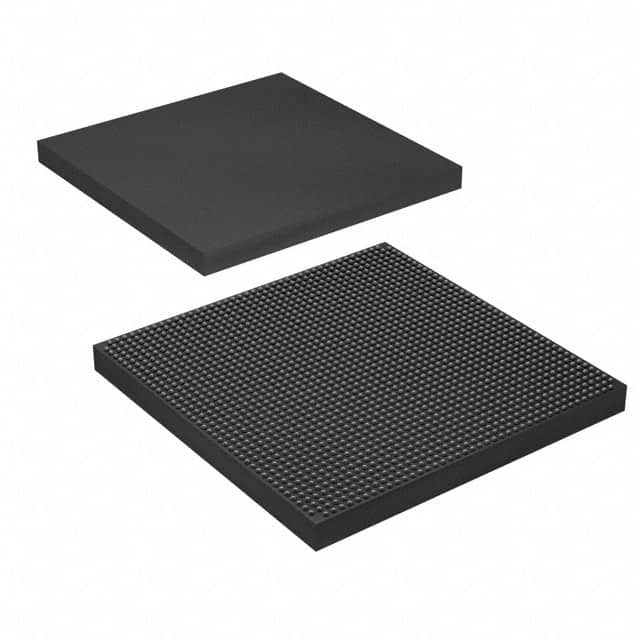5SGXEB6R2F43C3
Product Overview
Category
The 5SGXEB6R2F43C3 belongs to the category of Field Programmable Gate Arrays (FPGAs).
Use
This FPGA is designed for use in various electronic systems that require high-performance and flexible digital logic circuits.
Characteristics
- High-speed processing capabilities
- Configurable logic blocks
- On-chip memory resources
- Flexible I/O interfaces
- Low power consumption
Package
The 5SGXEB6R2F43C3 comes in a compact package suitable for surface mount technology (SMT) assembly.
Essence
The essence of this FPGA lies in its ability to be programmed and reprogrammed to perform specific functions, making it highly versatile and adaptable.
Packaging/Quantity
The 5SGXEB6R2F43C3 is typically packaged in reels or trays, with each package containing a specified quantity of FPGAs.
Specifications
- Logic Elements: 6,200,000
- Embedded Memory: 1,638,400 bits
- DSP Blocks: 960
- Maximum User I/Os: 1,040
- Operating Voltage: 1.2V
- Operating Temperature Range: -40°C to +100°C
Detailed Pin Configuration
The 5SGXEB6R2F43C3 has a complex pin configuration with multiple pins dedicated to different functions. Please refer to the datasheet for the detailed pin configuration.
Functional Features
- High-speed data processing
- Reconfigurable logic allows for flexibility in system design
- Integrated memory resources enable efficient data storage and retrieval
- Dedicated DSP blocks for optimized signal processing
- Support for various communication protocols and interfaces
Advantages
- Versatility: Can be programmed to perform a wide range of functions
- Flexibility: Allows for on-the-fly reconfiguration to adapt to changing requirements
- High-performance: Capable of handling complex computations and data processing tasks
- Reduced Time-to-Market: FPGA-based solutions can be developed and deployed faster than custom ASIC designs
Disadvantages
- Complexity: Designing and programming FPGAs requires specialized knowledge and expertise
- Power Consumption: FPGAs tend to consume more power compared to dedicated application-specific integrated circuits (ASICs)
- Cost: FPGAs can be more expensive than off-the-shelf microcontrollers or processors
Working Principles
The 5SGXEB6R2F43C3 operates based on the principles of configurable logic. It consists of an array of programmable logic blocks interconnected through a network of configurable interconnects. The desired functionality is achieved by configuring the interconnections and programming the logic blocks using a hardware description language (HDL) or a graphical design tool.
Detailed Application Field Plans
The 5SGXEB6R2F43C3 finds applications in various fields, including:
- Telecommunications: Used in base stations, routers, and network switches for high-speed data processing and protocol handling.
- Aerospace and Defense: Employed in radar systems, avionics, and military communication equipment for their performance and flexibility.
- Industrial Automation: Utilized in control systems, robotics, and machine vision applications for real-time data processing and control.
- Medical Devices: Integrated into medical imaging systems, patient monitoring devices, and diagnostic equipment for high-performance signal processing.
- Automotive: Used in advanced driver assistance systems (ADAS), infotainment systems, and engine control units (ECUs) for enhanced functionality and performance.
Detailed and Complete Alternative Models
- 5SGXEB6R3F43C3: A higher-end version with increased logic elements and memory resources.
- 5SGXEB6R1F43C3: A lower-cost variant with reduced logic elements but similar functionality.
- 5SGXEB6R2F40C3: A version with a different package and pin configuration, suitable for specific board layouts.
Please note that the above list is not exhaustive, and there may be other alternative models available in the market.
Word count: 570 words
Senaraikan 10 soalan dan jawapan biasa yang berkaitan dengan aplikasi 5SGXEB6R2F43C3 dalam penyelesaian teknikal
Sure! Here are 10 common questions and answers related to the application of 5SGXEB6R2F43C3 in technical solutions:
1. What is the 5SGXEB6R2F43C3 FPGA used for? The 5SGXEB6R2F43C3 FPGA is a Field-Programmable Gate Array (FPGA) that can be used in various technical solutions, such as high-performance computing, networking, and digital signal processing.
2. What are the key features of the 5SGXEB6R2F43C3 FPGA? Some key features of the 5SGXEB6R2F43C3 FPGA include a large number of logic elements, high-speed transceivers, embedded memory blocks, and support for various I/O standards.
3. How can the 5SGXEB6R2F43C3 FPGA be programmed? The 5SGXEB6R2F43C3 FPGA can be programmed using hardware description languages (HDLs) like Verilog or VHDL, or through graphical programming tools provided by the FPGA manufacturer.
4. Can the 5SGXEB6R2F43C3 FPGA be used for real-time applications? Yes, the 5SGXEB6R2F43C3 FPGA can be used for real-time applications due to its high-speed capabilities and ability to process data in parallel.
5. What kind of interfaces does the 5SGXEB6R2F43C3 FPGA support? The 5SGXEB6R2F43C3 FPGA supports various interfaces, including PCIe, Ethernet, USB, DDR3/DDR4 memory, and many other standard protocols commonly used in technical solutions.
6. Can the 5SGXEB6R2F43C3 FPGA be used in low-power applications? While the 5SGXEB6R2F43C3 FPGA is not specifically designed for low-power applications, it does offer power optimization features that can be utilized to reduce power consumption.
7. Is the 5SGXEB6R2F43C3 FPGA suitable for high-bandwidth data processing? Yes, the 5SGXEB6R2F43C3 FPGA is well-suited for high-bandwidth data processing due to its high-speed transceivers and ability to handle large amounts of data in parallel.
8. Can the 5SGXEB6R2F43C3 FPGA be reprogrammed after deployment? Yes, FPGAs like the 5SGXEB6R2F43C3 can be reprogrammed even after they have been deployed, allowing for flexibility and adaptability in technical solutions.
9. Are there any development kits available for the 5SGXEB6R2F43C3 FPGA? Yes, the manufacturer of the 5SGXEB6R2F43C3 FPGA provides development kits that include the necessary tools, documentation, and reference designs to aid in the development process.
10. What are some potential applications of the 5SGXEB6R2F43C3 FPGA? The 5SGXEB6R2F43C3 FPGA can be used in a wide range of applications, including high-performance computing, network acceleration, video processing, software-defined radio, and many more.
Please note that the specific details and capabilities of the 5SGXEB6R2F43C3 FPGA may vary, so it's always recommended to refer to the official documentation provided by the manufacturer for accurate information.


